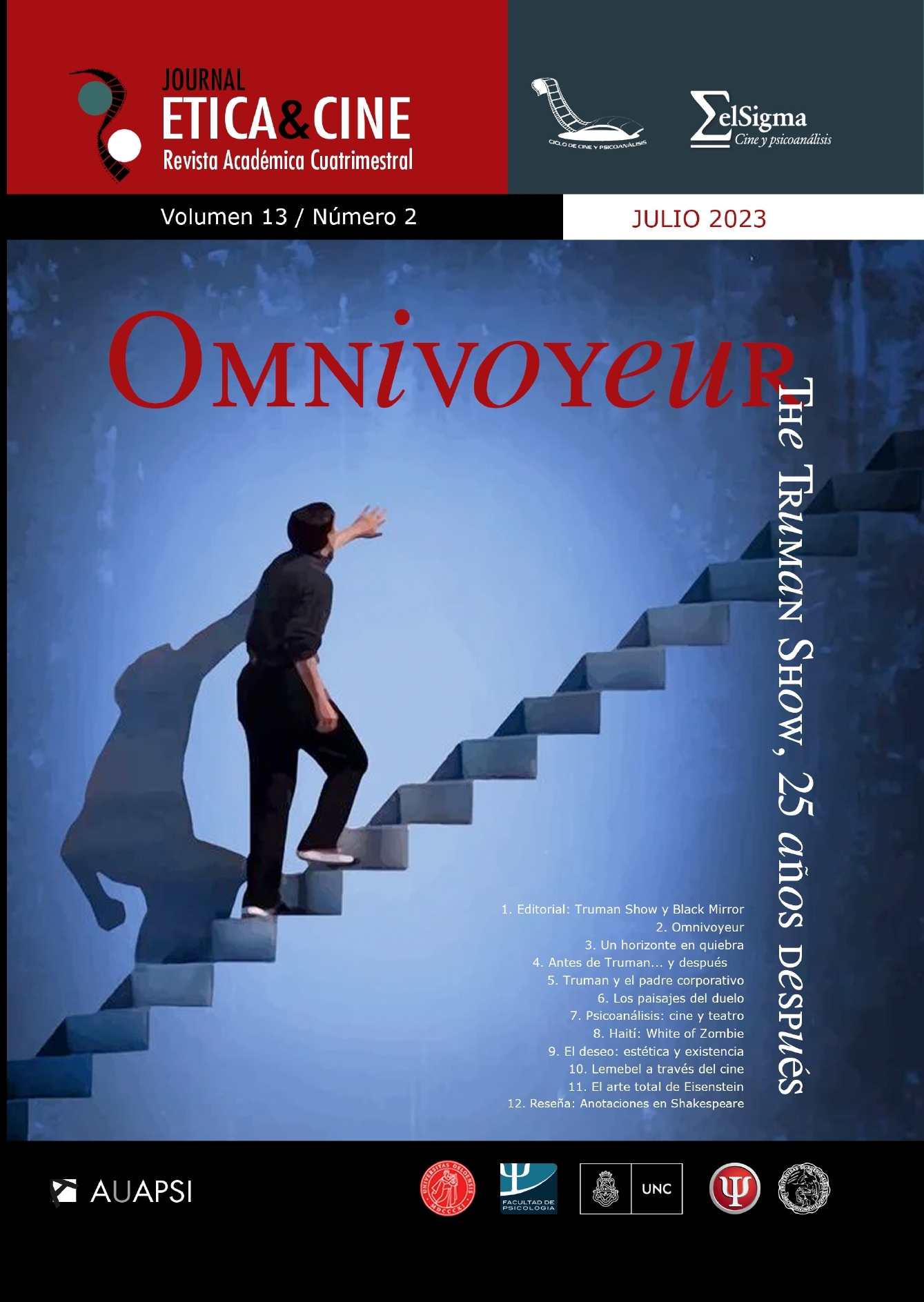Psychoanalysis in Cinema and Theater
The Reverse of the Message Between the Director and the Viewer as the Antithesis of Scientific Discourse
DOI:
https://doi.org/10.31056/2250.5415.v13.n2.41969Keywords:
Cinema, Psychoanalysis, Director, SpectatorAbstract
The film or theater director finds himself traversed by the discourse of his time and era, added to the works that he has previously digested to build his scripts and particular cinematographic style. Also, it has been disrupted by the influence of its viewers as direct consumers of his work. In this sense, the filmmaker recognizes himself not only during the creative process of the film in relation to expressiveness and communication with his actors, even his goal goes beyond the construction of the film, it requires a symbolic setting to share his message and finally be able to fully recognize himself through the criticism of the Other when he projects his long-awaited "final product". On the contrary, the spectator or film buff goes in another direction, since he does not carry out a catharsis or sublimation, but rather a complementary psychic work that consists of identification, embodied in the consumption and interpretation of the films he watches, because unconsciously the subject is a vector that is represented with many tragic and dramatic activities projected on the screen or in theaters.
Downloads
References
Referencias
Acosta, W. (2017). El cine como objeto de estudio de la historia: apuestas conceptuales y metodológicas. Folios, 47. 51-68. http://www.scielo.org.co/pdf/folios/n47/0123-4870-folios-47-00050.pdf
Álvarez, E. (2014). La memoria del cine o el cine que recuerda, en Josep M. Català (ed.), El cine de pensamiento: Formas de la imaginación tecno-estética, Colección Aldea Global, UAB / UPF / UJI / UV, pp. 189-203. https://dadun.unav.edu/bitstream/10171/36969/3/La%20memoria%20del%20cine.pdf
Baudrillard, J. (1974). La sociedad del consumo, sus mitos sus estructuras. Siglo XXI de España editores, S. A. Traducción de Alcira Bixio. https://ganexa.edu.pa/wpcontent/uploads/2014/11/ARTGBaudrillardJeanLaSociedadDeConsumoSusMitosSusEstructuras.pdf
Bacile, J., Cura, E., Liliana, V. (2015). Arte y psicoanálisis. Como el arte nos posibilita la tyche. VII Congreso Internacional de Investigación y Práctica Profesional en Psicología XXII. Facultad de Psicología - Universidad de Buenos Aires, Buenos Aires. chrome-extension://efaidnbmnnnibpcajpcglclefindmkaj/https://www.aacademica.org/000-015/773.pdf
Bosco, C. (2017). Breve historia universal del teatro. Universidad Nacional de Rosario.
Foucault, M. (2012). El nacimiento de la clínica: una arqueología de la mirada médica; Traducción de Francisco Perujo. Siglo XXI. Editores Salud y Sociedad.
Freud, S. (1905). “Análisis fragmentario de una histeria” (“Caso Dora”). Vol I, Obras Completas Biblioteca Nueva, Traducción Lopez Ballesteros, 1973.
Freud, S. (1912a). “El delirio y los sueños en la Gradiva de W. Jensen” en Obras Completas Tomo II. Biblioteca Nueva (1981).
Freud, S. (1912b). “Consejos al médico sobre el tratamiento analítico”, en Obras Completas Vol. XII, Amorrortu Editores 1980.
Gallo, H y Ramírez, E. (2012). El psicoanálisis y la investigación en la universidad. Grama Ediciones. Serie TRI.
Gallo, H. (2007). Afecciones contemporáneas del sujeto. La carreta Editores.
Jacobsen, M. (1995). Lacan. El amo absoluto. Amorrortu.
Lacan, J. (1995). El Seminario de Jacques Lacan. Libro 11. Los cuatro conceptos. Editorial Paidós. Buenos Aires.
Lacan, Jacques (2012), “Homenaje a Marguerite Duras por el arrobamiento de Lol V. Stein”, en Otros escritos, Paidós, Buenos Aires, pp. 209-216.
Lacan, J. (2007 [1959-1960]). El Seminario La Ética del Psicoanálisis. Libro 7. Editorial Paidós. Buenos Aires.
Martínez, J y Larrauri, O. (2010). Entre cine y psicoanálisis: un ensayo sobre sus desencuentros y afinidades. Razón y palabra, 2 (71), 1-24. http://www.razonypalabra.org.mx/N/N71/TEXTOS/MARTINEZ-REVISADO.pdf
Metz, C. (2002). Psicoanálisis y el cine: el significante imaginario. Paidós. Nueva Visión. Ed. Letra E.
Mordoh, E., Gurevicz, M., Thompson., Mattera., S. y Lombardi, G. (2004). Efectos analíticos del psicoanálisis. Facultad de Psicología - UBA / Secretaría de Investigaciones / XII Anuario de Investigaciones. http://www.scielo.org.ar/pdf/anuinv/v12/v12a25.pdf
Rey, C. (2017). Literatura y Psicoanálisis en Periferias. http://www.periferias.org/literatura-y-psicoanalisis/
Rodríguez, R. (2013). Producción: un reverso de la pulsión de muerte. Tesis Psicológica, 8 (2), 52-69. Fundación Universitaria Los Libertadores Bogotá. https://www.redalyc.org/pdf/1390/139029743005.pdf
Roudinesco, É. y Plon, M. (2008). Diccionario de Psicoanálisis. (Segunda ed.).
Ruiz, E. (2015). Psicoanálisis y cine, terapéutica y posibilidades de sublimación. Revista Psicoespacios, 9 (15), 350-363.http://revistas.iue.edu.co/index.php/Psicoespacios.
Saban, R. (2014). El psicoanálisis en el cine: primera sesión. Ética y Cine Journal, 4 (3), 35-43. https://journal.eticaycine.org/IMG/pdf/jeyc_noviembre_2014_07_saban_psicoanalisis.pdf
Saldías, P. y Solíz D. (2008). Un caso de transferencia (enfoque psicoanalítico). Ajayu, 6 (1) ,81-95 Universidad Católica Boliviana San Pablo. https://www.redalyc.org/pdf/4615/461545469005.pdf
Sinisterra, A. (2022). Reivindicación Paterna: a propósito del libro: La Invención de la Soledad de Paul Auster. [Trabajo de grado especialización]. Universidad de San Buenaventura Cali.
Žižek, S. (1994). Goza tu síntoma. Lacan en Hollywood. Traducido por Horacio Pons, Barcelona. https://elcinesigno.files.wordpress.com/2011/07/goza_tu_sintoma-_lacan_en_hollywood__slav.pdf
Zuleta, E. (2020). Arte y filosofía. Editorial Planeta Colombiana S.A.
locos. (27 de junio de 2011). Ernesto Sabato en Los siete locos (1995) [Archivo de Vídeo]. Youtube. https://www.youtube.com/watch?v=RlGh-Fmtp0o&t=1s
Downloads
Published
How to Cite
Issue
Section
License
Copyright (c) 2023 Ética y Cine Journal

This work is licensed under a Creative Commons Attribution-ShareAlike 4.0 International License.
Los autores que publiquen en Ética y Cine Journal aceptan las siguientes condiciones:
Los autores/as conservan los derechos de autor © y permiten la publicación a Ética y Cine Journal, bajo licencia CC BY-SA / Reconocimiento - Reconocimiento-CompartirIgual 4.0 Internacional. La adopción de esta licencia permite copiar, redistribuir, comunicar públicamente la obra, reconociendo los créditos de la misma, y construir sobre el material publicado, debiendo otorgar el crédito apropiado a través de un enlace a la licencia e indicando si se realizaron cambios.

Este obra está bajo una licencia de Creative Commons Reconocimiento-CompartirIgual 4.0 Internacional.




